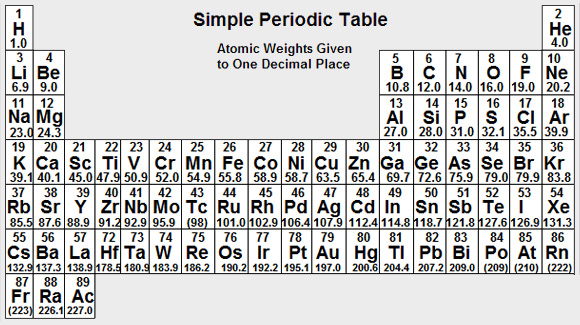For the next question, click on the Next Question button.
Question 1 of 3
What is the theoretical volume of Methane in litres (measured at 0°C and 760 mm Hg) produced from 23.9 grams of Trichloromethane in the following reaction:
-
Find the number of moles of Trichloromethane used.
Moles of Trichloromethane = Mass / RMM RMM = 119.5
Moles of Trichloromethane = 23.9/119.5 = 0.2 moles -
Find how many MOLES of Methane are produced.
From the balanced equation you can see that:
1 moles of Trichloromethane would produce 1 mole of Methane. Thus:
0.2 moles of Trichloromethane would produce 0.2 moles of Methane. -
Find the volume of Methane produced - as measured at 0°C and 760 mm Hg.
1 moles of Methane would have a volume of 22.4 litres. Thus:
0.2 moles of Methane would have a volume of 0.2 x 22.4 litres = 4.48 litres.
No, that is not the correct answer.
Have another go: just type in your new answer and press Enter.
If you continue to have problems, have a look at the answer.
For the next question, click on the Next Question button.
Question 2 of 3
What is the theoretical yield in milligrams of Sodium Sulphate in the following reaction, involving 25 ml of 0.1000M Sodium Hydroxide and 30 ml of 0.1000 M Sulphuric Acid?
Answer to 1 decimal place.
-
Find the number of moles of each of the reactants.
Molarity = Moles/Volume (in litres); thus: Moles = Molarity x Volume
Moles of Sodium Hydroxide = 0.1000 x 0.025 moles = 0.0025 moles
Moles of Sulphuric Acid = 0.1000 x 0.030 moles = 0.003 moles -
Find which of Sodium Hydroxide and Sulphuric Acid is the limiting reactant.
From the balanced equation, you can see that:
2 moles of Sodium Hydroxide would produce 1 mole of Sodium Sulphate. Thus:
0.0025 moles of Sodium Hydroxide would produce 0.00125 moles of the Sulphate.
1 mole of Sulphuric Acid would produce 1 mole of Sodium Sulphate
Thus 0.003 moles of Sulphuric Acid would produce 0.003 moles of Sodium Sulphate. -
Find the mass of Sodium Sulphate produced.
Mass = Moles x RMM RMM = 142.0
Mass = 0.00125 x 142 g = 0.1775 g = 177.5 milligrams to 1 dec pl
No, that is not the correct answer.
Have another go: just type in your new answer and press Enter.
If you continue to have problems, have a look at the answer.
Question 3 of 3
What is the theoretical yield in grams of Ethyl Iodide in the following reaction, involving 69 grams of Ethanol? Answer to 2 decimal place.
-
Find the number of moles of Ethanol used.
Moles of Ethanol = Mass/RMM RMM = 46.0
Moles of Ethanol = 69/46.0 = 1.5 moles -
Find the number of moles of Ethyl Iodide produced. Using the balanced equation:
6 moles of Ethanol would produce 6 moles of Ethyl Iodide. Thus:
1 mole of Ethanol would produce 1 mole of Ethyl Iodide. Thus:
1.5 moles of Ethanol would produce 1.5 moles of Ethyl Iodide. -
Find the MASS of Ethyl Iodide produced.
Mass of Ethyl Iodide = Moles x RMM RMM = 155.9
Mass of Ethyl Iodide = 1.5 x 155.9 g
Mass of Ethyl Iodide = 233.85 g to 2 dec pl
No, that is not the correct answer.
Have another go: just type in your new answer and press Enter.
If you continue to have problems, have a look at the answer.
